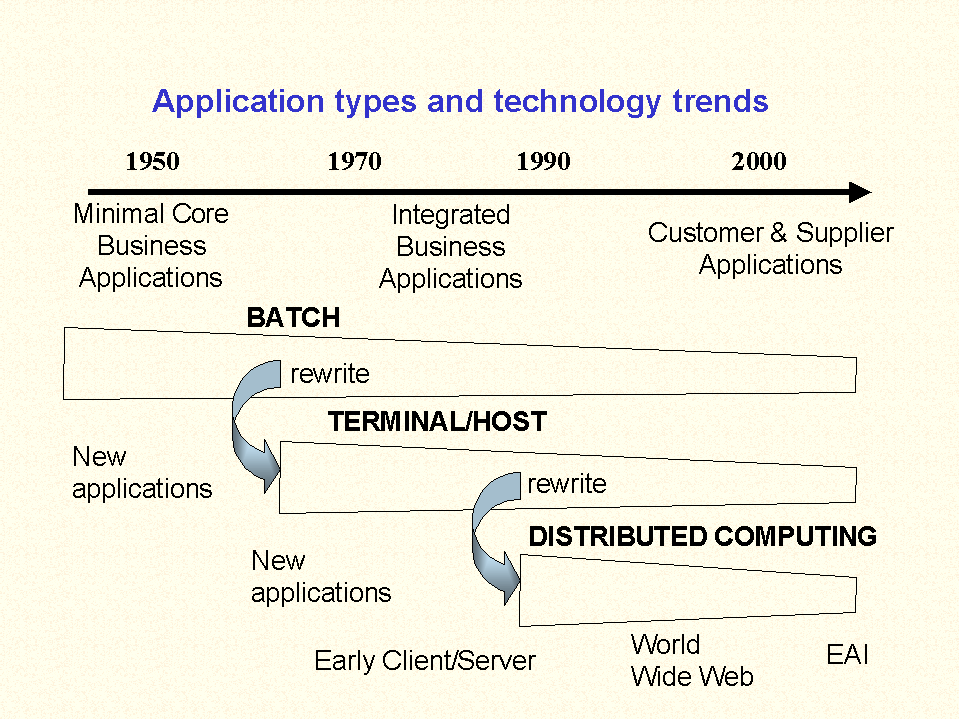|
|
|
| Revolutive IT™ |
|
Enterprise Application Integration References: Enterprise Application Integration, or EAI, can be defined as the combination of processes, software, standards, and hardware resulting in the seamless integration of two or more enterprise systems allowing them to operate as one. Although EAI is often associated with integrating systems within a business entity, EAI may also refer to the integration of enterprise systems of disparate corporate entities (B2Bi) when the goal is to permit a single business transaction to occur across multiple systems. Another definition could be following: EAI is the ongoing process of putting an infrastructure in place, so that a logical environment is created that allows business people to easily deploy new or changing business processes that rely on IT. 
Enterprise applications, from as early as the 1960s through the late 1970s, were simple in design and functionality, developed largely in part to end repetitive tasks. "There was no thought whatsoever given to the integration of corporate data. The entire objective was to replicate manual procedures on the computer." [1] By the 1980s, several corporations were beginning to understand the value and necessity for application integration. Challenges arose, though, as many corporate IT staff members attempted to redesign already implemented applications to make them appear as if they were integrated. Examples include trying to perform operational transaction processing (associated with enterprise resource planning (ERP) system functionality) on systems designed for informational data processing (data warehousing functionality). [2] As ERP applications became much more prevalent in the 1990s, there was a need for corporations to be able to leverage already existing applications and data within the ERP system; this could only be done by introducing EAI. [3] Frances Ren writes that the move towards EAI was a logical one. "Companies once used client/server technology to build departmental applications, but later realized the gains in linking multiple business processes." [4] Other issues driving the EAI market include the further proliferation of packaged applications, applications that addressed the potential problems of the Year 2000, supply chain management/business-to-business (B2B) integration, streamlined business processes, web application integration, and overall technology advances within EAI development. [5] What is involved in EAI? EAI is very involved and complex, and incorporates every level of an enterprise system - its architecture, hardware, software and processes. As defined by ITtoolbox, EAI involves integration at the following levels: Business Process Integration (BPI): When integrating business processes, a corporation must define, enable and manage the processes for the exchange of enterprise information among diverse business systems. This allows organizations to streamline operations, reduce costs and improve responsiveness to customer demands. [6] Elements here include process management, process modeling, and workflow, which involves the combination of tasks, procedures, organizations, required input and output information, and tools needed for each step in a business process. Application Integration: At this level of integration, the goal is to bring data or a function from one application together with that of another application that together provide near real-time integration.[7] Application Integration is used for, to name a few, B2B integration, implementing customer relationship management (CRM) systems that are integrated with a company's backend applications, web integration, and building Web sites that leverage multiple business systems. Custom integration development may also be necessary, particularly when integrating a legacy application with a newly implemented ERP application. Data Integration: In order for both Application Integration and Business Process Integration to succeed, the integration of data and database systems must be tackled. Prior to integration, data must be identified (where it is located), cataloged, and a metadata model must be built (a master guide for various data stores). Once these three steps are finished, data can then be shared/distributed across database systems. Standards of Integration: In order to achieve full Data Integration, standard formats for the data must be selected. Standards of Integration are those that promote the sharing and distribution of information and business data - standards that are at the core of Enterprise Application Integration. These include COM+/DCOM, CORBA, EDI, JavaRMI, and XML.Platform Integration: To complete the system integration, the underlying architecture, software and hardware, the separate needs of the heterogeneous network must be integrated. Platform Integration deals with the processes and tools that are required to allow these systems to communicate, both optimally and securely, so data can be passed through different applications without difficulty. For example, figuring out a way for an NT machine to pass information reliably to a UNIX machine is a large task for integrating an entire corporate system. Our solutions are the most efficient, flexible, quality-based and cheaper of the market, due to our fully innovative and customer-driven approach. Discover them and compare them to the solutions provided you by our competitors. |
| Copyright © 2002 Atlantis Technologies. All rights reserved. |